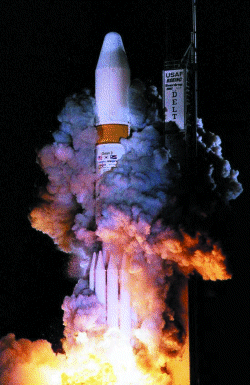Tim Furniss/LONDON
Boeing says that the debate over the success or failure of the third demonstration flight of the Delta III on 23 August is due to the launch being a "depletion burn mission" rather than one involving a commanded shutdown.

The Delta III, carrying a dummy satellite, failed to reach the published orbital apogee, resulting in suggestions that the mission was a partial failure.
Boeing says the debate has "resulted from the fact that we did not publish the expected orbital range for the mission and what we did publish was the pre-mission nominal apogee, which was calculated during initial planning stages for this mission."
In a commanded shutdown mission, the rocket flies to a specific point and the engine burn is terminated, whereas the depletion shutdown method aims to reach maximum altitude within a wider target apogee range, using all the available fuel. Future Delta III missions will typically use a propellant depletion shutdown technique, says Boeing.
"By the time we arrived at the flight readiness review, one week before launch, we had done more analysis to better determine the expected range," says Boeing, adding that it did not release this information.
On the launch date, Cape Canaveral also experienced a rare headwind, which contributed to the payload not reaching its intended apogee.
After analysis, the expected orbital range was calculated as 20,229km-24,031km (12,564-14,926 miles), says Boeing, compared with the 25,408km figure published in the pre-launch handbook.
"For depletion burn missions there is usually a relatively large range since you are not flying to a specific point in space, but maximizing the orbit achieved to maximize the potential lifetime of the spacecraft," it adds.
On depletion burn missions, the satellite will carry a liquid fuelled apogee motor and station-keeping thrusters feeding off the same system. The less propellant that is used to reach geostationary orbit, the more that is available for stationkeeping, maintaining a longer satellite lifetime.
"If this mission had been planned as a commanded shutdown mission, the nominal apogee would have been set at a much lower altitude to account for all of the variables and ensure that we ended the mission at a specific point.
"If this had been a commercial mission with an actual satellite it would have been a success," says Boeing.
Source: Flight International























